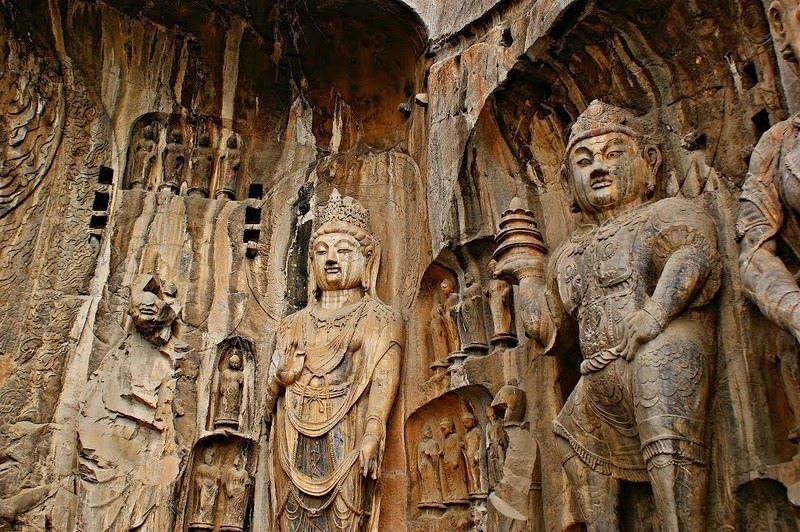Wonderful Longmen Grottoes, China
Longmen Grottoes are a series of Buddhist cave temples carved into the rock on the banks of the Yi River, south of the city of Luoyang, in Henan province, in China. The site includes some 1,350 caves and 40 pagodas, which are choke-full of statues of all shapes and sizes, ranging from 1 inch to the largest Buddha statue of 17 meters tall. There are as many as 100,000 statues carved out of the hard limestone cliffs. Stretching for 1 km along both banks of the river, the caves represent one of the finest examples of Chinese Buddhist art.
The Longmen Grottoes lie 12 km south of the historic Chinese city of Luoyang. Here are the two hills flanking the Yi River become very steep and cliff-like as they approach the river valley. It is here that the easily worked limestone was carved to produce the Longmen Grottoes.
Photo credit
Today, the Longmen Grottoes are a protected site. In 2000, it was inscribed upon the UNESCO World Heritage List.
Wonderful Longmen Grottoes, China
Photo credit
Wonderful Longmen Grottoes, China
Photo credit
Wonderful Longmen Grottoes, China
Photo credit
Wonderful Longmen Grottoes, China
Photo credit
Wonderful Longmen Grottoes, China
Photo credit
Wonderful Longmen Grottoes, China
Photo credit
Wonderful Longmen Grottoes, China
Photo credit
Wonderful Longmen Grottoes, China
Photo credit
Wonderful Longmen Grottoes, China
Photo credit
Sources: Wikipedia / UNESCO / Sacred Destination / China.org.cn /

Longmen Grottoes are a series of Buddhist cave temples carved into the rock on the banks of the Yi River, south of the city of Luoyang, in Henan province, in China. The site includes some 1,350 caves and 40 pagodas, which are choke-full of statues of all shapes and sizes, ranging from 1 inch to the largest Buddha statue of 17 meters tall. There are as many as 100,000 statues carved out of the hard limestone cliffs. Stretching for 1 km along both banks of the river, the caves represent one of the finest examples of Chinese Buddhist art.
The Longmen Grottoes lie 12 km south of the historic Chinese city of Luoyang. Here are the two hills flanking the Yi River become very steep and cliff-like as they approach the river valley. It is here that the easily worked limestone was carved to produce the Longmen Grottoes.
Photo credit
Today, the Longmen Grottoes are a protected site. In 2000, it was inscribed upon the UNESCO World Heritage List.
Wonderful Longmen Grottoes, China

Photo credit
Wonderful Longmen Grottoes, China

Photo credit
Wonderful Longmen Grottoes, China

Photo credit
Wonderful Longmen Grottoes, China

Photo credit
Wonderful Longmen Grottoes, China

Photo credit
Wonderful Longmen Grottoes, China

Photo credit
Wonderful Longmen Grottoes, China

Photo credit
Wonderful Longmen Grottoes, China

Photo credit
Wonderful Longmen Grottoes, China

Photo credit
Sources: Wikipedia / UNESCO / Sacred Destination / China.org.cn /

No comments:
Post a Comment
Note: only a member of this blog may post a comment.